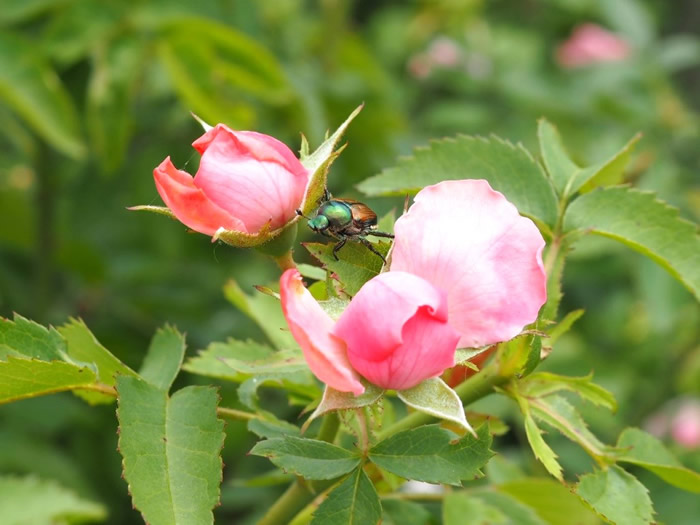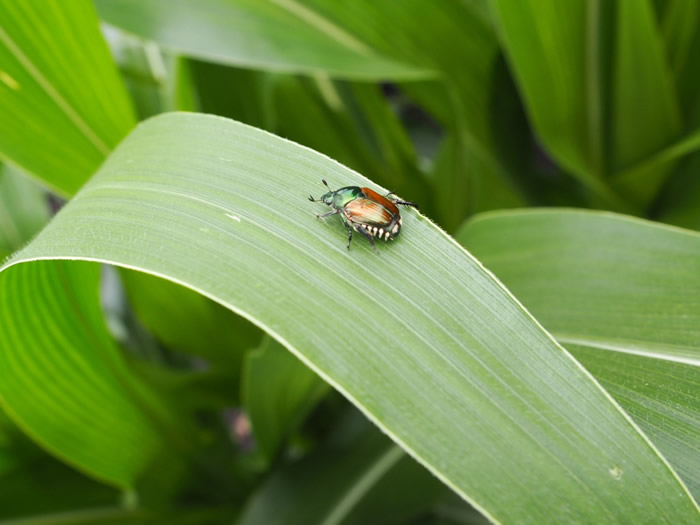Issue 6, July 1, 2020
Japanese Beetles on Ornamental Plants

Japanese beetle on rose, Sarah Hughson, University of Illinois at Urbana-Champaign.
They’re back! Adult Japanese beetles (Popillia japonica) have emerged in Illinois and are beginning to feed on ornamental plants. Japanese beetle adults have a broad host range, feeding on over 100 plants including linden, buckeye, rose, crabapple, apple, grape and raspberry. They may feed on the foliage, flowers and fruits of their host plants, skeletonizing leaves so only the leaf veins remain. Beetles tend to feed on and damage the upper portions of plants which can lead to heavy damage in the tops of trees. In some cases, this means that the damage can go unnoticed by passers-by and may not require treatment. While the damage can be unsightly, it does not usually result in dieback or the death of the plant.
Japanese beetle adults are conspicuous in the landscape and can be easy to identify. They are about 1/3 inch long with a metallic green head and pronotum, copper-brown wing covers and six white tufts of hair that run down each side of their body.

Japanese beetle on corn foliage, Sarah Hughson, University of Illinois at Urbana-Champaign.
Early control can help reduce future damage from these voracious herbivores because Japanese beetles are attracted to plants with previous feeding damage. Early control can also help reduce populations in the following year by killing adults before they deposit eggs.
Japanese beetles can be controlled by hand-picking. Beetles tend to drop off plants when they are threatened so they can be collected and removed by holding a cup of rubbing alcohol or water and soap beneath the beetles and knocking them into the liquid. This can be done every few days to control population if a chemical-free control method is preferred. However, this is time consuming and if populations are heavy, this method is not practical.
Some chemical controls that can be effective in treating adult Japanese beetles include carbaryl (Sevin), bifenthrin (Talstar), cyfluthrin (Tempo), lambda-cyhalothrin (Scimitar), or permethrin (Astro) foliar sprays. These foliar sprays can be effective in controlling adult beetles for about two weeks. Since Japanese beetle adults are active for about six weeks, more than one application may be required for control. Identify and treat susceptible plants that are focal points in the landscape rather than spraying a broad area. Because Japanese beetles are unlikely to feed enough to cause dieback or kill the plants, this can be effective in reducing aesthetic damage while reducing the use of insecticides in the landscape and protecting pollinators.
Japanese beetle larvae can be controlled by applying imidacloprid (Merit) to soil or turfgrass. This can be effective in controlling the soil-dwelling larvae for the whole summer. Imidicloprid is a systemic insecticide, meaning it is taken up by plants and transported to different plant tissues, including flowers and pollen. This can leave pollinators at risk for exposure to these toxins, so it is important to avoid applying imidicloprid or other systemic insecticides to flowering plants, including linden trees.
Remember to avoid Japanese beetle pheromone traps. Pheromone traps release attractant chemicals that are intended to lure beetles into a trap where they are killed. Unfortunately, in landscapes with attractive host plants, the traps tend to attract more beetles to the area, resulting in additional feeding and aesthetic damage.
Author:
Sarah Hughson